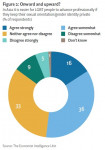Asia’s SMEs well placed for the regional recovery
Based on interviews with corporate officers at SMEs and regional experts, and a review of recent studies published by authorities such as the IMF, the Asian Development Bank (ADB) and national governments, the report assesses the challenges and opportunities facing SMEs in Asia, and China in particular, as the world emerges from a catastrophic recession. The fate of SMEs is particularly crucial since they account for the bulk of employment in many of the region’s economies and are the cornerstone of Asia’s entrepreneurial dynamism. They have been hit disproportionately hard by the global recession, particularly those companies reliant on exports, but they have shown a resilience and flexibility that bodes well for their ability to capitalise on the region’s unexpectedly rapid recovery.
The report’s key findings include:
· The times are tough, but Asia’s SMEs are tougher—and they are in the right region to take advantage of the upturn. Asia’s SMEs have faced a multitude of problems in recent months: a severe squeeze in financing, tumbling orders, diminishing cashflow and rising inventory costs. But some think the severe competition (at least among Chinese export-oriented manufacturers) and a “cost-control culture” have helped them develop resilience in adversity. On a macroeconomic level, they are well positioned to take advantage of the region’s surprisingly rapid growth.
· Cost control and inventory management are still crucial to survival. Although the region is recovering quickly, many SMEs are still in crisis mode and are focusing on cash-flow protection and strategic reassessment. Cost control, always important for small companies, has become crucial, as has inventory management (for example shifting to make-to-order production from stockpiling). The prompt collection of accounts receivable is also a priority—while quality control is gaining increased scrutiny to ensure clients have no excuse to delay or avoid payment.
· SMEs could benefit from a rebalancing of Asia’s largest economies. Given the weakness of Western markets, Asian SMEs, many of which are cogs in a global supply chain, would benefit from a new source of final demand within the region. There are signs that China may be able to provide this, as its middle class becomes richer and policymakers seek to rebalance its economy away from a reliance on exports and towards domestic demand. If this trend is sustainable (rather than just a result of massive fiscal stimulus in recent months) it could create a virtuous circle benefiting Asian exporters. Indeed, with Western consumers unlikely to return swiftly to pre-crisis levels of spending, some larger export-oriented SMEs are asking whether a strategy focusing on domestic markets—or at least reducing their reliance on consumers in the US and Europe—is preferable.
· A new intra-regional trade dynamic could help SMEs. If Asia’s larger economies do become sources of final demand, this will help drive intra-regional trade. It is already happening to some extent: the proportion of Asia’s trade within the region has been steadily rising over past two decades. The proliferation of free-trade agreements (FTAs) in Asia is testament to policymakers’ commitment to this goal. SMEs that already have cross-border business within Asia generally regard such agreements positively—and are hopeful that the China-ASEAN FTA, which came into effect in 2010, will be beneficial. Nevertheless, better official guidance and information is necessary if SMEs are to take advantages of Asia’s evolving trade dynamics.
“SMEs are the entrepreneurial lifeblood of the Asian economies, and those that have shown the toughness and flexibility to survive the financial crisis may well be tomorrow’s corporate stars,” says David Line, editor of the report.
Towards the recovery: Challenges and opportunities facing Asia’s SMEs is available free of charge at www.eiu.com/sponsor/fedex/towardstherecovery
About the Economist Intelligence Unit
The Economist Intelligence Unit is the business information arm of The Economist Group, publisher of The Economist. Through our global network of more than 650 analysts and contributors, we continuously assess and forecast political, economic and business conditions in more than 200 countries. As the world's leading provider of country intelligence, we help executives make better business decisions by providing timely, reliable and impartial analysis on worldwide market trends and business strategies. For more information, please visit www.eiu.com or follow us on www.twitter.com/theeiu
About FedEx
FedEx Express is the world's largest express transportation company, providing fast and reliable delivery to every U.S. address and to more than 220 countries and territories. Through its intra-Asia network, which connects 22 major cities, FedEx is helping SMEs seek out emerging trade opportunities within and across the Asia Pacific region. FedEx tailored portfolio of services is designed to meet the unique needs of SMEs with personalized services, innovations, tools and discounts focused on value, reliability, reach and service. For more information, please visit www.fedex.com
웹사이트: http://www.eiu.com
연락처
Joanne McKenna
+44 (0) 20 7576 8188
이메일 보내기
이 보도자료는 Economist Intelligence Unit가(이) 작성해 뉴스와이어 서비스를 통해 배포한 뉴스입니다.




